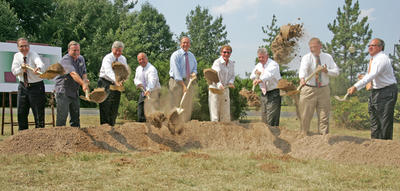
April L. Dowd photo
DUBLIN, IRELAND -- It was the early '50s in the tiny kitchen of a third-floor walk-up in Darby, a Philadelphia suburb then dominated by second-generation and recently arrived Irish.
The young visitor from New York is balking at the chicken dinner being put on the table in front of him.
"I don't like chicken," the young ingrate mutters to his gray-haired granny.
" 'Tisn't chicken, darlin' boy," she says in her light brogue, a hint of a smile playing around the creases of her work-worn face. " 'Tis Darby Duck, and there's no finer dish you can have in Ireland or here in my kitchen."
Quickly convinced, as kids often are by their elders, he dug into the dish with enthusiasm. "Darby Duck" had won a lifelong convert.
One fine night many, many years later, the ex-kid was sitting in a venerable old pub in Kinsale, a picturesque seaport town on the south coast of Ireland's County Cork, pondering what to have for dinner.
The most recommended dish was a roast chicken.
"Darby Duck," he thought. "Sure and there'll be no finer dish here in Ireland or even at home in my kitchen."
And, 'twas true.
We had headed for a motor vacation in Ireland determined to overcome the negative stereotype about Irish food. You know: "What's a seven-course Irish meal? A potato and a six-pack." "You can have your meat any way you like it, as long as it's mutton."
True foodies, the four of us -- the missus amd I plus Mr. & Mrs. Brown, our frequent traveling and dining colleagues -- assumed we could break the mold. Impossible, others told us. "Ireland is where you go to drink, not to eat." "I actually lost weight there in one week of bad food." And on and on.
Our first night in Ireland made us wonder a bit. We'd flown into Dublin, planning to motor around the east and south coasts, then up into the west coast wilds of County Clare -- where that old granny had come from -- before heading back down to Shannon and flying home eight days later.
We checked into our hotel -- the beautifully converted Clontarf Castle, site of one of the epic battles for Irish warrior king Brian Boru -- and asked for advice.
Where, we asked, is the best place for local food?
Well, said the bell captain in all seriousness, it depends on what you're looking for. The best in the city is Italian, Thai or Chinese.
Of course it is. And isn't that true in most places these days unless you're so far off the beaten path you're creating an entirely new one?
The ubiquity of various ethnic foods is widespread. Whether you're in Ireland or the States or in the Caribbean, Europe or Asia, you're assailed by many of the same choices -- Italian, Thai, Chinese, Indian, Pizza Hut, McDonald's, TGI Friday, KFC and so on.
We chose Italian, and after a very serviceable meal at a pasta palace, retired to our hotel.
Under a vaulted ceiling in the castle's stonewalled pub, one of the gentlemen in our party had a tall, lukewarm, alluringly dark Guinness draft while the other tried to get over his jet lag by teaching the pleasant young bartender how to make a bourbon Manhattan. Sort of a cross-cultural evening, but it set the tone for the beverage portion of our trip.
And then it was off for a 600-mile string of B&Bs, sheep, village and city pubs (one of them, Cruise's in Ennis, County Clare, was founded in 1654), sheep, breathtaking vistas, sheep (as humor writer Dave Barry has noted, Ireland appears to be an island slowly being consumed by sheep), makers and purveyors of crystal and sweaters, sheep, and some interesting meals. And sheep.
In the aforementioned Kinsale pub, we dined on excellent roasted chicken: lightly seasoned, succulent white meat, browned skin with no hint of greasiness -- Darby Duck at its finest, plus oven-browned potatoes, tender carrots, dense soda bread slathered with the rich Irish butter and pots of robust dark tea.
And, of course, some of our party opted for a pint or three of the Guinness while some others helped along another pillar of the Irish economy by surrounding a few drams of smooth, golden Jameson's whiskey.
(As a concession to the many Americans who flood the island each year, it no longer is an effort to get a bit of ice in your drinks.)
Of course, there were other, more elaborate meals here and there that show the emergence of continental-trained chefs bringing their newly honed skills back home to broaden the cuisine -- a particularly fine set of fork-tender beef medallions in a green peppercorn/sherry/cream sauce; a Cajun-spiced chicken sandwich with a tomato-paste salsa topping the equal of any sandwich saucing I've ever had; fresh-caught salmon or sole that you know just came off the fishing boat at the local pier; calorie-be-damned ice cream sundaes draped in honey or butterscotch or dusky, cocoa-y chocolate; any kind of potatoes (and at many meals you got french fries -- "chips" -- in addition to mashed, boiled or roasted potatoes), and wonderful yeasty white breads and flavored soda breads.
So, while I'd never consider Ireland a cuisine destination place, I'd certainly argue against the notion that it's a nation of culinary Philistines. A little intelligent scouting around will help you uncover food just like at home, or something with a bit of a local flavor.
Virtually all the pubs serve food, and sitting on the bar side of a pub/restaurant will usually get you the same menu but at a reduced price. The saving comes from having to go to the bar and bring back your own drinks, and sit at little cocktail tables rather than full-size tables. But that's a tiny thing for the 10 to 20 percent saving. And when you're in a true Irish pub, the last thing you want to do is be in the restaurant separated from the bar and the conversation (real conversation, about life and love and politics and travel and finance) and -- sterotypical as it sounds -- the frequent impromptu sing-alongs.
And you don't have to be a drinker to take up space in a pub. Soft drinks (from Coca-Cola to the delicious local Finches sodas) as well as juices, coffee or tea are not an unusual order.
But wait, you say, what about the "full Irish breakfasts" of tourist legend?
Ahhh, `tis true about them. A bowl of porridge, a rack of toast with rich butter and marmalade, orange juice, a platter of fried or scrambled eggs, broiled tomatoes, Irish bacon (closer to what we call Canadian bacon), slices of fried pudding (more like a dense sausage, either "white" or "black" pudding, the former made with meal and spices and sometimes a bit of meat, the latter made dark with blood), plus a carafe of strong tea or coffee with rich fresh cream.
Does everyone in Ireland eat breakfast like this?, we asked the slim hostess of a hotel restaurant located on the promenade of Galway city, overlooking misty Galway Bay.
"Oh, Lordy no," said she. "That's mostly for the tourists. If you ate like that all the time it'd kill you."
ON THE WEB
• The New Irish Cuisine
